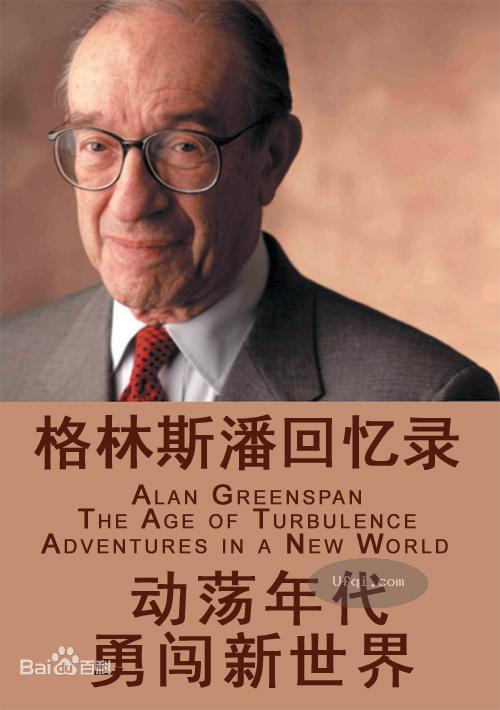


2023-04-30 , 8635 , 104 , 143
美联储主席艾伦格林斯潘回忆录——动荡年代:勇闯新世界-the age of turbulence-14
THE MAKING OF AN ECONOMIST
Changing jobs was a remarkably easy decision. Besides the Fortune work, I had a steady stream of freelance research projects, and new clients were always calling. I had no real obligations—Joan and I had already decided to separate, and within a few months I would be moving back to Manhattan and would rent an apartment on Thirty-fifth Street.
Townsend-Greenspan opened for business in September 1953. (We were officially incorporated in 1954.) Our offices were on Broadway, a little south of the New York Stock Exchange. The space was nondescript, with just an office for Bill and one for me and a common area where two research assistants and a secretary sat.
Bill and I operated on separate tracks. Bill continued to put out his letter and to work with his investment-advisory clients. My first accounts were people who knew me from the Conference Board. The Wellington Fund, predecessor to the Vanguard Group, was the first to sign on. Republic Steel, America's third-largest steelmaker, was next, and within two years, ten more steel companies followed, including U.S. Steel, Armco, Jones & Laughlin,
Allegheny-Ludlum, Inland, and Kaiser. For Townsend-Greenspan, this was the best possible advertisement. Steel was the symbol of American
strength, and if you ran your finger down the Fortune 500 list, which appeared
for the first time in 1955, those names were right near the top. We gradually added a whole range of clients—Alcoa, Reliance Electric, Burlington Industries, Mellon National Bank, Mobil Oil, Tenneco, and many more.
A casualty was my Ph.D.—I was just too busy to get it done. Several times each month I'd have to hop on a plane to call on clients in Pittsburgh or Chicago or Cleveland; the rest of the time, I was racing to create reports.
I was torn because I liked the topic I'd chosen for my dissertation: the spending and saving patterns of American households. But taking the oral exams and completing the dissertation would require at least six solid months, and to do that, I'd have to scale back my business. I convinced myself I wouldn't lose anything by dropping out, because I'd continue to read
and study economics in my work. But every couple of months, I'd run into Professor Burns. He'd always say, "When are you going to get back to work?"
I always felt a pang. (Much later, in the 1970s, I did return to graduate school, at NYU, and completed my Ph.D.)
The key to Townsend-Greenspan's appeal was our ability to translate economic analysis into a form business leaders could apply in making de
45
cisions. Say the economy was entering a period of growth. The typical industrial
CEO was most likely a salesman or an engineer or a general manager who had worked his way up in the company. Knowing what the gross national product (GNP) was going to do wasn't useful to him. But if you talked to the CEO of an automobile-parts manufacturing company and could tell him that "assemblies for Chevrolet over the next six months are going to be different from what General Motors has announced/' that was something he could understand and act on.



Today's supply chains are so totally integrated that information between suppliers and manufacturers flows freely—it's how modern just-in-time manufacturing works. But back then; the relationship between manufacturers and suppliers was more like a poker game. If you were a purchasing manager at an appliance manufacturer looking to buy steel sheet to make refrigerators, telling the steelmaker's salesman how much sheet you already had in inventory would only weaken your bargaining position.
The lack of such information left the steel company flying partially blind in planning its production. Moreover, many of our steel clients' customers knew only their part of the market. The steel outlook could be radically affected by a shift in demand for passenger cars, or skyscraper construction, or oil-drilling pipe, or even tin cans. And that demand, in the short run, was a reflection of the demand for inventories as well as steel to be consumed.
A forecast system is only as good as the accuracy of its historical database from which future turns in a cycle can be projected. I'd take into account historical levels of car and truck output, aircraft assemblies, and more. Data on steel shipments by product and consuming industry I'd get from the American Iron and Steel Institute each month, and data on exports (the United States was heavily exporting steel in those days) and imports (almost none) from the Department of Commerce. Combining shipments of domestically produced steel products with imports and exports gave me the tonnage of each product's receipts by consuming industry. The next challenge was to figure how much of each historical quarter's steel receipts
the buyers had consumed, and how much had been added to or subtracted from the buyers' inventory. For that I went back to World War II and Korean War data: the government had declassified masses of statistics on the metals industries from the War Production Board, which had been in charge
46
THE MAKING OF AN ECONOMIST
of Uncle Sam's industrial rationing system. Each industry that consumed steel—autos, machinery construction, oil drilling—had a unique inventory cycle, and all of them were documented there.
Further analyzed, those figures, combined with my newly acquired macroeconomic forecasting capabilities (thanks to Sandy Parker), enabled us to project the level of aggregate steel-industry product shipments. Over time, we were also able to track individual steel company market shares—
which meant a producer could make informed decisions, given the outlook for shipments, as to where to shift its resources in the coming quarters to
maximize its profit.
By 1957 I'd worked with the steel companies for several years. Late that year, I flew to Cleveland to make a presentation to the executive committee of Republic Steel, whose CEO was Tom Patten. My system indicated that inventories were building rapidly and that the industry's production
rate was therefore well above the rate at which steel was being consumed.
Production was going to have to come way down just to stop the accumulation.
And it wasn't just the steel industry that was facing a big problem.
"Nineteen fifty-eight is going to be an awful year," I told them. Patten took issue with that: "Well, the order books are pretty good," he said. Republic Steel stuck to its production schedule.
About three months later, demand for steel plunged. It was the onset of the 1958 recession, which turned out to be the sharpest business downturn since the war. When I was next in Cleveland, Patten generously acknowledged in front of the executive committee, "Well, you got it right, my friend."



UfqiLong
Predicting the economic downturn that became the 1958 recession was my first forecast of the economy as a whole. Spending as much time studying the steel industry as I did put me in an excellent position to see the downturn coming. Steel was a much more central force in the American economy then—the economy's strength was much more in durable goods, most of which are made of steel. I could extrapolate the wider consequences of steel's weakening, and warn other, nonsteel clients as well.
Still, while calling the 1958 recession benefited our reputation, it
47
wasn't successful macroeconomic forecasting per se that our clients found most useful. Our work was an analytical evaluation of the forces making the current economy do what it was doing. Forecasting is simply a projection of how current imbalances will ultimately resolve. Our service was to deepen our clients' understanding of the exact nature of the relationships between forces; what they did with that information was up to them. CEOs
of large corporations are not going to take the word of a thirty-year-old kid as to where the economy is going. But they might very well listen to what he thinks are the various balances here and there, especially if they can check this input against their own knowledge. I'd try to talk on their terms:
not "What's the GNP doing?" but "What is the demand for machine tools six months out?" or "What is the likelihood of the markup changing between broad-woven fabrics on the one hand and the market for men's suits on the other?" I would define what was going on in general terms and then translate that into the implications for individual businesses. That was my value-added, and we prospered.
Working with heavy industry gave me a profound appreciation of the central dynamic of capitalism. "Creative destruction" is an idea that was articulated by the Harvard economist Joseph Schumpeter in 1942. Like many powerful ideas, his is simple: A market economy will incessantly revitalize itself from within by scrapping old and failing businesses and then reallocating resources to newer, more productive ones. I read Schumpeter in my twenties and always thought he was right, and I've watched the process at work through my entire career.
The telegraph was a perfect illustration. By the time my friend Herbie and I had set out as kids to learn Morse code in the late 1930s, the telegraph industry was at its peak. Starting in the heyday of those quick-fingered operators in the 1850s and 1860s, it had transformed the entire American economy. By the late 1930s, well over half a million telegrams were being sent per day, and the Western Union messenger boy was as familiar a sight as the FedEx person is now. Telegrams tied together cities and towns across America, compressing the amount of time it took businesses and people to communicate, and connected U.S. industrial and financial markets to the rest of the world. They were the way all important or urgent family and business news arrived.
48
(未完待续, To be contd)



🔗 连载目录
🤖 智能推荐



